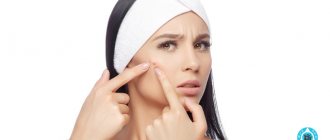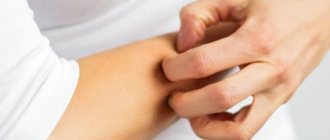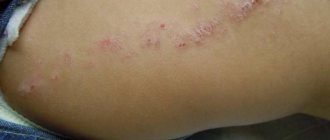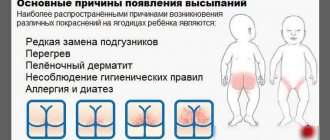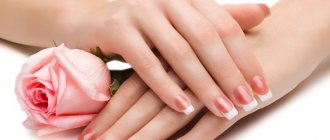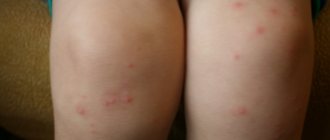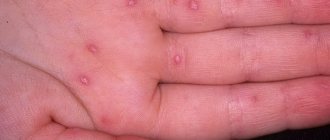A rash on a child's legs occurs for several reasons. These are infectious and allergic diseases, disorders of the circulatory system. In the latter case, we are more often talking about hemorrhagic vasculitis.
At home, it is impossible to independently determine the cause, focusing on certain symptoms. Therefore, you should contact a specific specialist (allergist or pediatrician) to prescribe appropriate treatment.
Pimples on a child's legs
Young children often get sick.
They have very sensitive skin and mucous membranes. Almost all children are allergic to food or hygiene products. There are no sebaceous glands on children's hands and feet, so acne on the thighs is much more common. Quite often the skin on a child’s bottom becomes inflamed, which is very sensitive to overheating, dirt, and bacteria.
It is necessary to periodically bathe the baby, wash his genitals, change diapers, and take walks in the fresh air from time to time.
Causes of rashes on feet
The feet are a part of the body where there is no hair or sebaceous glands, so you can immediately rule out diseases of these skin appendages, a typical symptom of which is red pimples in children (acne, folliculitis).
Children love to walk barefoot, so there is a possibility of infection through microcracks in the skin.
Products used to clean floors and carpets can also cause an inappropriate reaction in the body, since children are much more sensitive to environmental factors compared to adults.
It is very important to identify the cause of the rash in time and take appropriate measures.
A rash on a teenager’s foot can take different forms:
- bubbles filled with liquid;
- red pimples on the child’s legs that resemble bumps, hard to the touch;
- dry pimples on the butt and legs, accompanied by cracks;
- purulent (rarely occur on the foot);
- intradermal, which resemble lumps and are accompanied by inflammation of the surrounding tissues.
What is the reason for the appearance of a rash in such an unusual place? It most often occurs in children with reduced immunity, impressionable and sickly.
Sometimes acne on a child's legs can become inflamed when wearing synthetic tights or socks, washing their feet with inappropriate products or choosing uncomfortable shoes. Overly warm boots can cause overheating of the skin, which leads to inflammation.
Among the diseases that manifest as a rash on the foot are:
- Dyshidrosis.
- Dyshidrotic eczema.
- Allergic dermatitis.
- Fungal skin lesions.
It is very important to know the causes of small pimples, even if the child does not yet suffer from the disease.
A characteristic symptom of dyshidrosis is acne in a child, mainly on the palms and soles. Allergic manifestations can affect any part of the body.
They can be local (under the influence of an allergen especially on the child’s heels) and generalized (due to general intoxication).
Fungal infections affect the feet, causing unbearable itching, and the nails break and peel. The differences between different types of rash are clearly visible in the photo.
Symptoms of diseases that are accompanied by acne on the feet
There are a number of pathologies, the characteristic symptoms of which are rashes on the hands and small pimples on the feet. Before making a diagnosis, the doctor must carefully examine the patient.
If the rash on children’s legs becomes purely local, it is worth considering the following ailments:
- Dyshidrosis occurs due to excessive sweating, causing blockage of the sweat glands. When the air temperature rises, overwork, or stress, the palms begin to sweat intensely, and a rash appears on the child’s knees. It is also found on the thighs. Small pimples on the leg may be the result of an allergy to food or clothing items, if this is no longer an infant
You should carefully monitor their hygiene in order to promptly remove secretions, which are an excellent breeding ground for pathogenic bacteria.The rash in appearance resembles watery pimples on the legs, which over time fill with pus. They are very itchy, accompanied by aching pain and peeling of the skin.
The pimple can merge with an adjacent rash, causing significant skin damage.
- Dyshidrotic eczema. The reason is the increased work of the sweat glands. It is accompanied by the accumulation of fluid under the skin, resulting in watery pimples on the legs and palms. If antiseptic rules are not followed, pimples may become infected. Elements of the child's rash itch and are accompanied by swelling. When the blisters burst, they can leave behind painful sores.
- Allergic (itching) dermatitis. With this disease, the skin itches very much. Children become capricious, restless, and constantly scratch small pimples on their legs. The reason is that the allergen gets on the skin or inside the body with food. Its role can be detergents, chemicals, dyes, synthetic fabrics. With this disease, red pimples in children may appear on the butt, thighs and other areas of the lower extremities. A generalized allergic reaction, which causes red pimples on a child's legs, can develop into anaphylactic shock, so parents should be very careful.
Very often, children whose legs are constantly under clothes develop a disease such as prickly heat.
In children, the skin has increased sensitivity to the negative influences of the external environment. It is worth carefully monitoring hygiene, using only baby soap and shampoos.
Other causes of acne on the lower extremities
Endocrine disorders (diabetes mellitus, obesity, hypothyroidism) can be accompanied by swelling and the formation of various types of rashes. The normal ratio of substances in the body changes. The skin, as an indicator, quickly reacts to changes throughout the body.
Pimples on a child's feet may be accompanied by elevated blood glucose levels. Against the background of frequent acute respiratory diseases, immunity is significantly reduced, which can be accompanied by rapid fatigue and disruption of the intradermal glands.
In diabetes mellitus, the vessels of the lower extremities suffer, which is accompanied by a disruption of their blood supply and tissue hypoxia.
Infectious diseases such as scabies, molluscum contagiosum, and fungal pathogens can affect the foot area. They require special treatment aimed at boosting immunity and antibacterial therapy.
Perhaps at first there was only a small injury, which, if hygiene rules were not followed, turned into infected wounds. Dirty towels and visiting the public pool and beach can contribute to foot infections.
Acne on the knees of an adult can occur due to improper hair removal.
Common illnesses that affect young children are scarlet fever, measles and chickenpox
Childhood diseases that are accompanied by the spread of a rash:
- chickenpox - acne on the knees of a child occurs last, a blistering rash spreads from top to bottom, can affect the mucous membranes, and also appear on the child’s leg;
- acne caused by overstrain of the nervous system, red pimples in children resemble an allergic reaction;
- with scarlet fever, rubella and measles, the lymph nodes enlarge, the temperature rises, intoxication of the body occurs, pain and ulcers in the mouth are possible, sometimes during illness patients claim that red areas have appeared on their legs;
- scabies - the scabies mite makes passages under the skin, causing severe itching and pimples on the toes, and can simultaneously affect the hand;
- foot fungus - white pimples, which is accompanied by peeling of the skin; the pathogenic pathogen causes an unpleasant odor on the child’s foot.
Treatment of rashes on the lower extremities
Today, there are various treatment methods based on the experience of dermatologists around the world. Specific therapy is based on combating the cause that caused the disease.
General recommendations include:
- calm environment, opportunity to relax
- measures aimed at strengthening immunity;
- exclusion of allergenic products, synthetic clothing, exclusion of home repairs;
- mother's positive attitude;
- in the presence of a bacterial infection, antibiotics are appropriate;
- symptoms of an allergic reaction can be eliminated with the help of antihistamines;
- isolation of the patient from other children if we are talking about an infectious disease.
The choice of drug therapy depends on the specific disease:
- antiseptics (iodine, brilliant green, hydrogen peroxide) are indispensable for any skin pathology;
- streptocidal ointment has an anti-inflammatory, antibacterial, softening effect;
- if there is a fungal infection on the child’s heels, fungicidal drugs are prescribed (in the form of ointments, creams and tablets);
- chicken pox does not pose a significant danger; you should treat the blisters with an antiseptic and try to normalize a very high temperature.
Only a doctor can choose the right treatment
You cannot self-medicate. When it comes to an infectious disease, it is better to show the patient to an experienced dermatologist who can make a diagnosis. Acne on a child's legs can pose a risk of complications, so timely diagnosis is key in the treatment of meningococcal infection.
Meningococcal infection is very dangerous. First, a pimple appears on the body, then pimples appear on the child’s knees.
Harmless primary symptoms such as runny nose, cough, fever are accompanied by small pimples on the body after 2-3 days. The nature of the rash resembles subcutaneous hemorrhages.
First, a pimple appears on the body, then pimples appear on the child’s knee.
Features of the occurrence of blackheads
Dark spots appear for two reasons:
- high load on the lower limbs;
- skin disease.
People who stand on their feet for a long time, wear uncomfortable shoes, have flat feet, actively play sports, are faced with the problem of dark red, brown, and blackheads. The dark spots do not hurt and disappear after a short period of time if you start using comfortable shoes and avoid unnecessary physical activity.
Warts are a common occurrence and are characterized by the presence of small black dots. They themselves rarely disappear, grow and multiply quickly, and cause heel itching and pain. The virus can be found anywhere: a black dot on the toe or sole indicates that the tissue is infected.
Rash in children: what happens and where does it most often appear?
The child's body is most often exposed to infectious diseases, since the child's immunity is still too weak. Also, the cause of all kinds of infections is the state of intestinal microbiocenosis.
Types of rashes in children
Infectious damage to a child’s body often leads to a rash. To avoid possible complications when any type of rash appears, you should contact a specialist (pediatrician). The location of the rash is very variable. Any part of the body can fall into the active rash zone.
Rash in the form of red dots
This rash, like small red dots, most often occurs due to allergic reactions. Perhaps this is due to the diet, the foods consumed, and the tissues adjacent to the body.
Properties, characteristics, reasons:
- On the body, such a rash looks like red dotted spots that have an oval, round shape.
- Has no elevation above other parts of the body. The rash is distinguished only by color.
- The appearance of red dots occurs due to strong blood supply. Hyperemia or arterial congestion increases blood flow, which leads to the appearance of such spots.
- Red dots may have edges or edges. Or they can be solid.
This rash is divided into two main types:
- Roseola. A characteristic feature of this type of rash is its small size. It ranges from 3 to 30 millimeters.
- Erythema . This rash is distinguished by the large size of its elements. From 3 centimeters. It is most often located in the chest area. The characteristic color is bright scarlet.
Important! If the treatment is not provided correctly, depigmentation may form at the site of redness and dots. And the treatment will no longer lead to the initial result (clean and healthy skin). In this case, it is necessary to resort to surgical intervention.
Pimple-like rash
Acne is the body's reaction to various external or internal environmental factors. Pimples also appear due to allergic reactions and infectious diseases.
Main characteristics, description, causes of acne:
- This rash has different shapes and types. It may appear as an abscess. It rises above the skin level and forms a round pustule.
- The size of such a rash is not very large. About 1-1.5 millimeters in height.
- Shaped image: round pimple, cone-shaped pimple, internal (flat) pimple.
- The main cause of acne in young children is allergic reactions. This rash may be accompanied by itching and redness.
- The appearance of acne can also be caused by hereditary factors. This disease can be transmitted from mother to child.
- Stress often leads to this type of rash.
Acne rashes are divided into 4 groups (according to appearance and nature of inflammation):
- Dry acne . The formation of such acne occurs in the winter season in both children and adults. They appear due to thickening of the stratum corneum of the epidermis. Treatment is provided with cosmetics that exfoliate dead skin particles and moisturize the skin.
- Watery pimples. They appear for many reasons (diathesis, consumption of low-quality food, use of low-quality cosmetics - shampoos, creams, foams, soaps), but the most common is an allergic reaction to the product. Watery pimples are accompanied by itching. May be a symptom of scabies, measles, chickenpox, rubella, dyshidrosis.
- Purulent acne. At first, this rash may appear as small red dots, but after three to four days changes occur. Red spots turn into purulent pimples. This rash may be caused by a staph or streptococcal infection. It is necessary to do a complete (clinical) blood test, a general urine test, and then consult a specialist. During the test period, you should avoid sweet foods to prevent bacteria from multiplying.
- Subcutaneous pimple. The occurrence of such acne occurs due to blockage of the ducts by plugs of the sebaceous glands. Usually this phenomenon goes away on its own, but if no changes occur, you should consult a specialist for advice.
Blistering rash
The appearance of a blistering rash can lead to a number of very dangerous diseases:
- Pemphigus. This disease can lead to death in a child. The immune system is damaged when the body begins to fight healthy cells.
- Dermatitis herpetiformis, which is an autoimmune disease. A feature of this disease is the appearance of bubbles and blisters.
The blistering rash can come in two forms:
- It may make up about 50% of the human body. Appears in different parts of the body.
- Appears in a separate part of the body, forming only small round itchy redness.
This rash can appear due to:
- Allergic reactions of the body, skin.
- Systemic diseases.
- Skin diseases.
- Infectious diseases.
After healing, the bubble disappears, leaving no marks on the body.
To begin a course of treatment, it is necessary to identify the cause and stage of the disease, for which you need to contact a specialist.
Rash in the form of spots
This rash looks like spots with different colors (red, pink, yellow, brown). The color of the spot depends on melanin (skin pigment). If melanin is present, then the color of the skin with areas of spots will be darker. If melanin is absent, the color shade of the spots becomes brighter and lighter.
You might be interested! Small red dots on the body: what are they?
A rash in the form of spots characteristic of diseases such as:
- Measles
- Rubella
- Scarlet fever
- Skin tumors
- Various skin diseases.
Features of the rash in the form of spots:
- The rash is caused by hundreds of viral agents.
- This rash has a tendency to merge from small round spots into larger spots.
- Skin lesions most often occur in the chest (torso) area of the child.
- The rash may appear due to food, contact, or drug allergies.
To accurately determine the level of this disease, identify the cause, and correctly prescribe treatment, you need to consult a specialist.
List of doctors who should be contacted for a rash in the form of spots:
- Dermatologist
- Neuropathologist
- Oncologist
- Allergist
- Surgeon
Here you can read more about red spots on the face.
Description of the main elements of the rash
The main elements of the rash:
- Tubercles are cavityless formations protruding above the general level of the skin, 1-5 millimeters in size (sometimes reaching up to 10 millimeters). The tubercles are capable of forming ulcers or healing by replacing the infiltrate with the formation of an element of cicatricial atrophy of the skin in place.
- Blisters are formations with a strong inflammatory process. The size of the blister reaches 10 centimeters. The skin inflammation is pale pink at the base and bright red in the middle of the element.
- Bubbles are small, liquid-filled cavity elements. Their diameter is about 10 millimeters. They can occur due to burns, bites, various skin diseases, and allergic reactions. Vesicles (bubbles) arise as a result of the manifestation of diseases such as herpes infection, allergic dermatitis, autoimmune bullous diseases.
- Spots are flat rashes on the human body. Their standard diameter is about 10 millimeters. The spots come in different sizes, forming over a period of time inflamed areas of skin that are larger in diameter.
- Papules (also called a node) are formations of varying consistency that protrude above the main level of the skin. They are divided into two types: inflammatory and non-inflammatory. Dimensions reach 5 millimeters. The shape is different.
- Vesicles are small cavity formations of hemispherical shape. The internal contents include a clear or translucent liquid. Differs from a bubble in its smaller size.
- Pustules are pustules. The pustule contains gray or white pus inside. When infected, the pus becomes greenish in color.
- Roseola are small spots that do not rise above the skin level. Groups of spots usually form.
- Hemorrhage is bleeding into the skin due to the destruction of blood vessels. On the skin it looks like small spots or dots of different shapes. It has a red and then yellow color (during healing).
Characteristic location of the rash in children
Baby rash has different locations. The main location of a particular rash leads to the initial detection of the disease. A child's rash can be located in different places of the body, causing irritation, itching, acute pain, and discomfort.
So, the main location of the rash in children:
- The rash is located on the arms, elbows, wrists, and forearms.
- Sometimes the rash appears on the legs (inside the leg). The most common cause is allergic reactions of children to food, but more complex cases also occur.
- Most often, rashes occur on the face. The focal point is the cheeks.
- The torso is also subject to inflammatory processes. Most often, rashes occur in the chest area, as well as in the scapular region.
Diseases accompanied by rash
Diseases that are accompanied by a rash:
- Allergic reactions often cause an active rash on the body . Each child has its own allergen, which is extremely difficult to detect. An allergic rash is easily noticeable - small dots, pimples, and blisters form all over the body, which rise above the skin level. Typically the diameter of such elements is approximately 5 millimeters.
- Infection . Appears after contact with a sick person. A striking example of this group of diseases is chickenpox. First, a high temperature develops; after three to four days of illness, characteristic rashes appear on the child’s body.
What is the difference between an infectious rash?
Infection (measles, rubella, chickenpox) is a contagious disease.
It has the main distinguishing qualities from allergic and other diseases:
- Lymph nodes enlarge.
- Peeling of the skin. This quality is characteristic of many infectious diseases.
- Bubbles containing liquid form.
- Subcutaneous hemorrhages are most characteristic of measles.
With such symptoms, it is necessary to obtain qualified assistance from a specialist.
For which rash should you see a doctor?
Any rash on the body has serious consequences. Parents first of all pay attention to this condition of the child and think little about the consequences.
Important! Any rash in a state of active reproduction can lead to serious consequences. Self-medication in this situation is unnecessary and even dangerous. Any rash requires the attention of a doctor.
It is impossible to describe all cases of the appearance of a rash; it can be a consequence of more than a hundred allergic and infectious diseases and conditions of the child’s body.
Therefore, any rash requires consultation with a doctor.
Material updated: 12/21/2018
Types of rashes
Have you been trying to heal your JOINTS for many years?
Head of the Institute for the Treatment of Joints: “You will be amazed at how easy it is to cure your joints by taking the product every day for 147 rubles .
Rash refers to a broad medical concept. A large number of reasons lead to its appearance. Rashes are pathological elements on the skin and mucous membranes, differing in color and texture.
Our readers successfully use Sustalaif to treat joints. Seeing how popular this product is, we decided to bring it to your attention. Read more here...
Colorless and white rashes
When white spots on the sole of the foot do not cause any discomfort, being only a cosmetic defect, they speak of the presence of vitiligo.
It develops when the dermis loses its natural pigmentation due to changes in melanin. Then individual parts of the body lose their normal color, which leads to the appearance of white spots and variegation.
The factors for the development of vitiligo in the foot area have not been fully identified. Certain pathological processes, drug use, hereditary factors, and stress can provoke the appearance of white spots on the soles of the feet.
Red rashes
Spots in the area of the feet can rise above the plane of the sole or be completely flat.
Their colors range from pale pink to rich wine red. If the heel is red, a person may experience itching and peeling.
Often, any change in skin pigmentation is the result of an imbalance, a disease of the body - allergic reactions, an unbalanced diet, vascular changes, skin diseases.
- Warts. The human papilloma virus is “to blame” for their occurrence, which penetrates through small lesions under the skin, after which its cells become keratinized. Public places are the main carrier of pathogens.
Additional provoking factors:
- poorly chosen, uncomfortable shoes;
- acquired and congenital leg defects (flat feet, osteoarthritis, arthritis, etc.);
- diseases that result in impaired nutrition of cells and tissues (diabetes mellitus, varicose veins, etc.);
- immunodeficiency;
- microtrauma of the skin.
Pimples on a child’s legs – what to do?
Young children often get sick. They have very sensitive skin and mucous membranes. Almost all children are allergic to food or hygiene products.
There are no sebaceous glands on children's hands and feet, so acne on the thighs is much more common. Quite often the skin on a child’s bottom becomes inflamed, which is very sensitive to overheating, dirt, and bacteria.
It is necessary to periodically bathe the baby, wash his genitals, change diapers, and take walks in the fresh air from time to time.
Rash on a child’s legs: photos of rashes on the feet, hips, heels and other parts of the limbs
Rashes in children are common and occur for many reasons. In addition, the rash itself can occur in various forms and be accompanied by additional symptoms.
Why does a rash appear on the legs of babies at different ages? What is its appearance and location? What to do about rashes? What methods will help cure the disease?
Causes of rashes on the legs in children of different ages
Rashes on the legs appear for many reasons. These are factors of infectious, allergic, systemic and other origin. In particular, the symptoms depend on the causes of the rash.
The main causes of rashes on the legs of a child:
- infectious diseases (rubella, measles, scarlet fever, chickenpox, etc.);
- parasites (scabies, dust mites);
- allergic reaction (to pollen, clothing, pets, cosmetics, etc.);
- insect bites (we recommend reading: how can you treat a child’s mosquito bite at home?);
- fungus (rash appears on the feet and heels);
- lack of hygiene;
- atypical reaction to cold or direct sunlight, etc.
READ ALSO: scabies in children: symptoms with photos
Infectious diseases
When the cause of the rash is an infection, in addition to the characteristic pimples, additional symptoms are necessarily present. The baby is worried about severe itching or burning, chills, increased body temperature, abdominal pain, nausea and other signs of intoxication of the body.
Infectious diseases that are accompanied by a rash:
- chickenpox (in this case, small blisters are present throughout the body, but at the beginning of the disease can be localized only on the lower extremities);
- measles;
- rubella (we recommend reading: symptoms with photos and treatment of rubella in children);
- meningococcal infection;
- scarlet fever, etc.
First, a pathogenic virus enters the child’s body, passes through the protective barrier of the immune system and begins to become active. Several days usually pass from the moment of infection to the appearance of the first symptoms.
Allergic reaction
Allergies are the most common cause of rashes or pimples. This could be a food allergy or a reaction to the environment and medications. Contact allergies most often lead to rashes on the legs (hips, feet, legs).
Possible allergens:
- food products (milk, chocolate, honey, berries, etc.);
- medications (for oral administration and for local use - ointments, creams);
- flowering plants and herbs (nettle and other herbs during flowering);
- household chemicals (laundry detergents);
- cosmetics (bathing gel, foam, cream, powder);
- clothing made from low-quality synthetic materials or dyed with chemical dyes;
- synthetic underwear and socks (irritation appeared on the heels, ankles, butt, between the legs);
- Pets;
- bed sheets;
- unsuitable diapers;
- reaction to insect bites (mosquitoes, midges) (we recommend reading: what do allergic reactions with photos to mosquito bites in a child look like?).
READ ALSO: What is the best way to anoint a child’s mosquito bite?
Blood diseases
In some cases, diseases of the circulatory system (blood and blood vessels) manifest themselves in the form of dermatological problems. They have their own characteristics, significantly different from allergies or infections, as can be seen in the photo below.
Basically, with pathologies of the blood and blood vessels, hemorrhagic rashes of various types occur. In fact, these are not pimples, but small hemorrhages of blood vessels into the skin. Hemorrhagic vasculitis may look like small red dots, spots, bruises or hematomas (we recommend reading: hemorrhagic vasculitis in children: symptoms, photos and treatment). The legs and feet are usually affected.
Sometimes individual lesions merge into one large and swollen spot. In addition to visible symptoms, the child exhibits signs of intoxication (headache, fever, chills, nausea, weakness), joint pain.
Thrombocytopenic purpura leads to the appearance of asymmetrical spots (we recommend reading: thrombocytopenic purpura: photos of manifestations in children). This happens when platelet levels drop significantly.
An ulcerative rash on the soles may indicate advanced pathology of the circulatory system. In children, such a disease is rare.
Poor hygiene
Failure to comply with personal hygiene rules often leads to skin irritation and rashes. Infants and infants are especially often affected.
A common problem is heat rash. It is characterized by the appearance of small blisters or pimples. Appears due to poor quality child care, high room temperature, or “steaming” the baby in too warm and synthetic clothes that do not allow air to pass through.
The formations usually cover the butt, thighs, groin area, folds under the knees, and armpits. Miliaria can be papular, red (red nodules) and crystalline (small transparent blisters). At the same time, the skin flakes, dries and itches.
Other reasons
Other factors:
- Eczema or psoriasis. Characterized by a red rash with white blisters filled with fluid. After the papules burst, yellowish crusts form. The skin peels, itches and hurts.
- Hormonal disorders. Typical not only for teenagers. Hormonal shift provokes any disruption in the endocrine system.
- Avitaminosis. A lack of essential vitamins and microelements will certainly affect the skin that needs them. In addition to exacerbation of dermatological problems, dry skin, peeling, and hair loss appear.
- Fungus. Usually affects the feet and toes. These are rashes or blisters that, without proper treatment, turn into painful ulcers. There is also an unpleasant odor, inflammation, and cracks.
- Pseudotuberculosis (we recommend reading: symptoms and treatment of pseudotuberculosis in children). A pink-blue rash affects the area of the “socks” without accompanying symptoms. It happens in children older than 6 months.
- Neurodermatitis. Children's feet become covered with red papules with exudate. The skin itches and hurts. Unpleasant symptoms worsen at night.
Types of rash on the legs and its location
In some cases, the location of the rash may indicate the root cause of its appearance. For example, with allergies, irritation appears at the site of skin contact with the allergen. From poor-quality socks - on the feet and ankles, from diapers - on the butt and in the groin area.
A rash on a child’s feet indicates a fungus or neurodermatitis. Blood diseases affect the legs and feet. Miliaria manifests itself in places covered by clothing and folds (under the knees, in the armpits).
READ ALSO: foot fungus in children: symptoms with photos, treatment methods
The term "rash" is general. It combines the names of various skin pathologies, which differ in appearance and nature of manifestation. In the photo below you can see different types of rashes.
Types of rash, as well as the reasons that can cause it:
- Small rash (red or pink). Allergic reaction, prickly heat, fungus, psoriasis, scabies, rubella. In each individual case, additional symptoms are present (fever, chills, itching, cracking or peeling).
- Large red. Large pimples in the form of “stars” all over the body indicate infection with meningococcus, which is extremely dangerous for infants and newborns. Large pimples only on the lower extremities indicate scabies (scabies mite).
- Transparent, colorless. Occurs with allergies, fungus, vitamin deficiency, hormonal imbalance and disorders of the gastrointestinal tract.
- Pimples (individual or in a large group). They appear in various pathologies and under the influence of the environment. Heat rash, allergic reaction, sunburn, chapping, streptococcus infection (streptoderma), dysbacteriosis, diabetes, poor hygiene, hormonal changes or disorders (for example, in a teenager), reaction to a vaccination or a new medicine.
- Rough dry. A characteristic symptom of scarlet fever. Accompanied by high fever, weakness, significant redness of the throat and tongue. Very contagious, transmitted by airborne droplets. Rough papules or nodules are present in atopic dermatitis.
As the disease progresses, spots and pimples can change into blisters and ulcers. Inflammation begins in the absence of timely medical care.
Diagnostic methods
If suspicious rashes appear, you should immediately go to the doctor. First, go to the pediatrician for an initial examination, then to specialists (allergist, immunologist, dermatologist, infectious disease specialist, gastroenterologist, etc.).
General blood and urine tests are required. An additional blood test may be needed to detect infection (viruses, bacteria, fungus), special immunoglobulins (indicate an allergic reaction). In case of advanced pathology, the doctor will take scrapings from the affected areas of the epidermis.
Treatment tactics depending on the causes of the symptom
A rash on a child’s legs requires qualified medical care. Treatment depends on the nature of the pathology. Often, adjusting your lifestyle and quality of life leads to improvements almost immediately. Complex treatment includes eliminating the underlying cause, external manifestations on the skin (local treatment), maintaining good hygiene, and proper nutrition.
Special therapy is prescribed by a specialist. It involves taking antiviral, antibacterial or antifungal drugs. However, most diseases require full child care, diet, and local treatment to relieve inflammation and itching.
Medications:
- age-appropriate antiallergic drugs - they relieve tissue swelling well and reduce discomfort (Fenistil, Erius, Zyrtec, Suprastin, Diazolin, etc.);
- corticosteroid ointments or creams;
- hormonal drugs for external use (Prednisolone, Kenalog, etc.);
- immunomodulators or immunostimulants (used in extreme cases in children after 3 years of age);
- ointments or gels to reduce inflammation and itching, as well as for rapid healing (Fenistil gel, Bepanten, Weleda, etc.);
- antiseptics - if necessary (Betadine, Chlorhexidine, Miramistin).
In addition to drug therapy, it is important to take care of personal hygiene, nutrition, and the environment. You should bathe your baby daily using soft baby products or just warm water (for babies). You need to give up low-quality cosmetics.
It is important to review your household chemicals, especially laundry detergents. It is better to switch to environmentally friendly hypoallergenic brands. The room must be clean. Bed linen, underwear and clothing should be made from natural fabrics.
If the cause of the problem is an allergy, you need to isolate the baby from the allergen, incl. provide a hypoallergenic diet. In other cases, especially with vitamin deficiency, it is important to review the baby’s diet. Good nutrition is important, which includes eating lean meat, fish, dairy products, vegetables, fruits, and cereals.
Preventive actions
Preventing rashes in children:
- strengthening the immune system;
- maintaining personal hygiene;
- use of quality care products;
- hypoallergenic household chemicals;
- high-quality shoes and clothing made from natural materials;
- proper nutrition (if necessary, exclusion of allergenic foods);
- wearing clothes appropriate for the weather by the child;
- timely and correct treatment of diseases;
- regular pediatrician visits and tests;
- careful attention to the health and well-being of the baby.
Chinese method of treatment
Chinese doctors have long and successfully used the points responsible for human organs to treat people. For example, more than 70 thousand nerve endings are concentrated on the sole of the feet. For the Chinese, the foot is like a map of internal organs, which can even be used to diagnose their pathologies.
Biologically active points are associated with the work of various systems and organs, influencing which can help get rid of pathologies. Therefore, it has always been considered useful to walk barefoot on grass and earth to get a boost of energy and prevent many diseases.
